Affiliate Tracking is an essential element of any affiliate network. Since affiliate marketing is a performance-based concept, its effectiveness depends largely on marketers’ ability to evaluate their affiliate campaigns’ performance. A smooth allocation of transactions is crucial to a successful affiliate program and, if an affiliate succeeds in generating leads, they must be reimbursed in a timely and efficient manner.
So, how do we make sure all the transactions are tracked precisely? There are a few affiliate tracking methods we are going to discuss today!
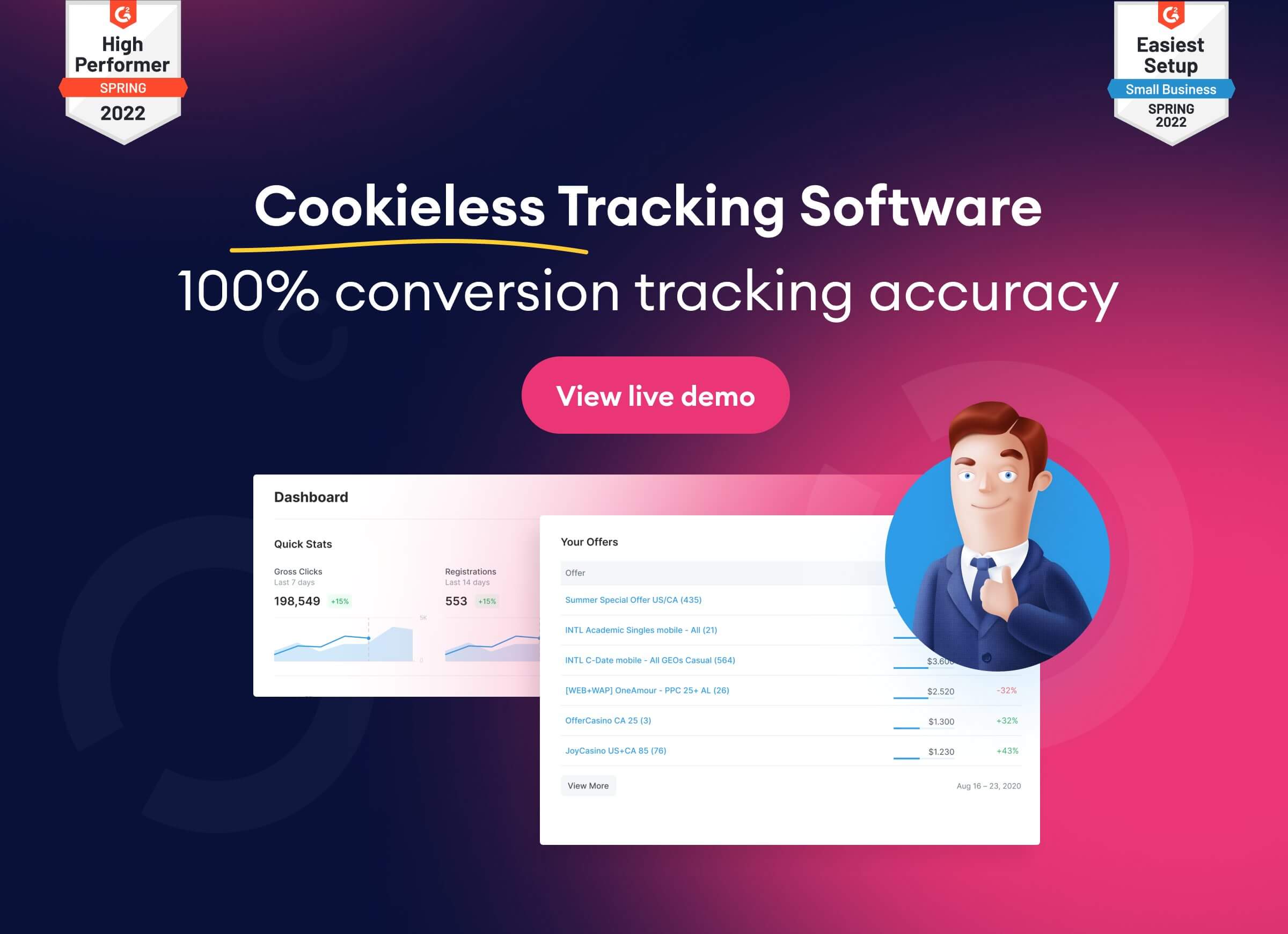
Affiliate tracking in a nutshell
Generally speaking, affiliate tracking software is used to monitor referrals, leads, or orders made by an individual or a company from another person or company.

Tracking is required to manage and reward participants in the affiliate networks efficiently.
- Participants who consent to be endorsed or promoted are referred to as “affiliates.”
- Those who sell and recommend are called “affiliate marketers.”
- Those with the goods or services sold are called “advertisers.”
Affiliate networks are mid-cap firms that handle marketers and advertisers acting as brokers.
The affiliate tracking software, the foundation of every affiliate business, can be hosted on its own server or run in a SaaS cloud. The purpose is to capture page views and clicks of promotional content (banners, ads, etc.) while tracking affiliate conversions, i.e., events the advertiser is willing to pay for. Examples may include:
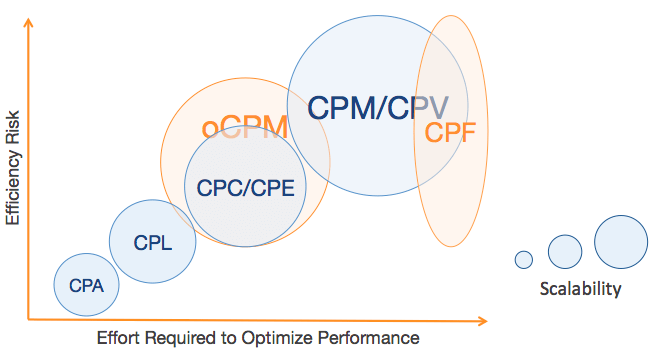
- CPC (Cost per click)
- CPA (Cost per acquisition)
- CMP (Cost per impression)
- CPS (Cost per sale)
- CPI (Cost per install)
- CPL (Cost Per Lead)
- CPV (Cost Per Visitor)
- CPO (Cost Per order)
The tracking applies to user-client IP identification, browser detection, marketer affiliate referral, and an advertiser’s completed transaction.
Popular Methods for Tracking Affiliate Marketing Campaigns
There are several popular methods for tracking affiliate marketing campaigns, including:
- Cookies: Cookies are small files that are stored on a user’s computer and can be used to track their activity on a website. When a user clicks on an affiliate link, a cookie is placed on their computer that contains a unique identifier. This identifier is then used to track the user’s activity on the website, including any purchases they make.
- Tracking URLs: Tracking URLs are unique URLs that contain a unique identifier or tracking code. When a user clicks on an affiliate link that includes a tracking URL, the tracking code is recorded, allowing the affiliate to track the user’s activity on the website.
- SubIDs: SubIDs are additional parameters that can be added to tracking URLs or cookies to provide more detailed tracking information. For example, an affiliate might use a SubID to track the specific marketing campaign or advertisement that generated a sale.
- Attribution software: Attribution software is a type of software that tracks and attributes conversions to specific marketing campaigns or channels. This can be useful for affiliates who are running multiple campaigns or using multiple marketing channels, as it allows them to see which campaigns are most effective.
A key feature of affiliate marketing software is data consolidation, enabling marketers and advertisers to perform different marketing optimization routines.
How do you know which links will result in conversions?
In order to know just how useful affiliate links are, it’s necessary to monitor affiliate conversions.
Essentially, you need to know which links lead to new customers, transactions, subscriptions, or user behavior you define as a ‘conversion.’

It all begins with a click – which precedes any other action the user has taken. By clicking on the affiliate link, users can open a specific product or service’s landing page. Each affiliate link must have a collection of different parameters in its URL to address a few issues:
- Is the conversion valid?
- Where did the user come from, and which affiliate link did he click?
- Did they make a purchase (i.e., the conversion took place)?
Tracking various user behaviors requires different affiliate marketing tracking methods, which we will cover in this article. However, they can be roughly broken down to:
1 – Customer-based tracking
Customer-based tracking uses cookies on the customer’s end. Cookies are placed in the user’s browser by clicking on an ad that leads them to the landing page.
If the conversion takes place, a conversion pixel will appear, then read the cookie information (transaction ID) and send it back to the system used to track the conversions.
2 – Server-to-server tracking
Generally speaking, server-to-server tracking works by creating and storing a unique identifier of some kind when a user clicks a tracking link (or generates an ad impression). When a conversion (or other trackable action) is made later by the same user, the unique ID is returned to the advertiser. This is achieved by returning the same unique identifier to the tracking server.
Which tracking method is better?
The ease of installing an iframe or JavaScript pixel for cookie tracking is more appealing, but server-side tracking is definitely advantageous.
In most instances, the transaction ID is linked to a fixed parameter, such as an email address or username, resulting in a higher degree of accuracy. Another advantage of server-side tracking is incorporating extra third-party tracking so that the affiliate can use the transaction ID to check the affiliate marketing campaign results independently.
Accuracy is the key benefit of server-to-server monitoring. By creating a unique ID when clicking or ad viewing, you get a higher degree of accuracy in tracking a particular transaction back to a specific affiliate.
Now, let’s break down all the most popular affiliate tracking methods:
Cookie-based affiliate tracking
This is one of the most popular methods of affiliate tracking. As Internet users, we are aware of cookies because we receive new prompts about them every time we visit a new website.

Cookies are intended to remind users, particularly those who visit a website more than once.
There are 1-st party cookies (which pose no concern to the user’s privacy, as they are used only to remember logins, items added to the shopping cart, etc.) Also, there are also 3-rd party cookies, which are used – as the name suggests – by 3rd parties.
Read more about cookies:
- Alternatives to 3rd-Party Cookies in the EU & Worldwide
- The Future of Affiliate Marketing After Cookies & Tracking IDs Restriction
Traditionally affiliate marketing is driven by cookies, which is a technology that communicates with a web browser to store information, including:
- user preferences
- login details or registration information
- shopping cart content
If you’ve ever accepted cookies to read content on a website or opted-in to remember your password and username on the website, you’ve had a first-hand experience with cookies.
Have you ever searched online for “cat food” and then seen banners displaying special cat food offers on other websites?
This is the result of a cookie being dropped on your browser during the initial search, saving the search data as something that may interest you and enabling you to be targeted later. These cookies are typically set to last 30 days, but they can differ by brand.
In the case of affiliate marketing, cookies store a link or an ad that the website user has clicked on. Cookies can also store a variety of data attached to this click, including the time and date of the click and the type of website you visited.
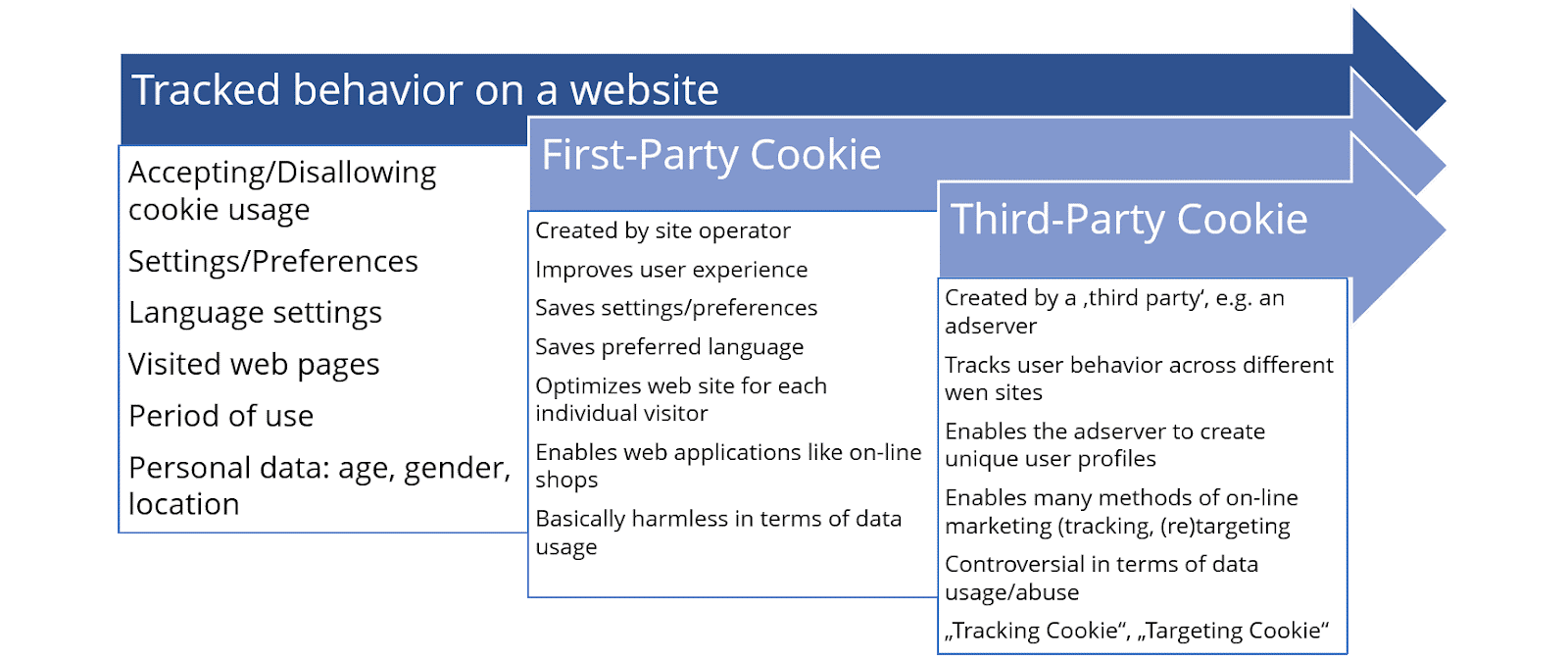
There are many different types of cookies; however, the most common type of cookie used in affiliate marketing is considered a first-party cookie. When a visitor reads content from the publisher’s website and clicks through to buy (either by clicking through an advertiser’s banner, an ad display, or a text link), a cookie is dropped in the browser. This cookie helps us recognize the advertiser, the publisher, and, thus, the commission’s amount. This data is stored in the link information of the cookie, known as “custom parameters.

Cookie tracking cons:
The major drawback of cookie tracking is that any user can easily erase them from their browser.
In addition, cookies cannot be tracked across multiple devices belonging to a single person.
Postback URL affiliate tracking
We have already covered Postback URL tracking in our ultimate guide to Postback tracking, but we will briefly dive into it here.
Postback URL tracking is a privacy-friendly tracking method. Moreover, this approach is one of the most reliable methods of tracking and monitoring performance. It operates on a server-based method, which ensures that no conversion is omitted. All the bits of information are kept on the advertiser’s server.
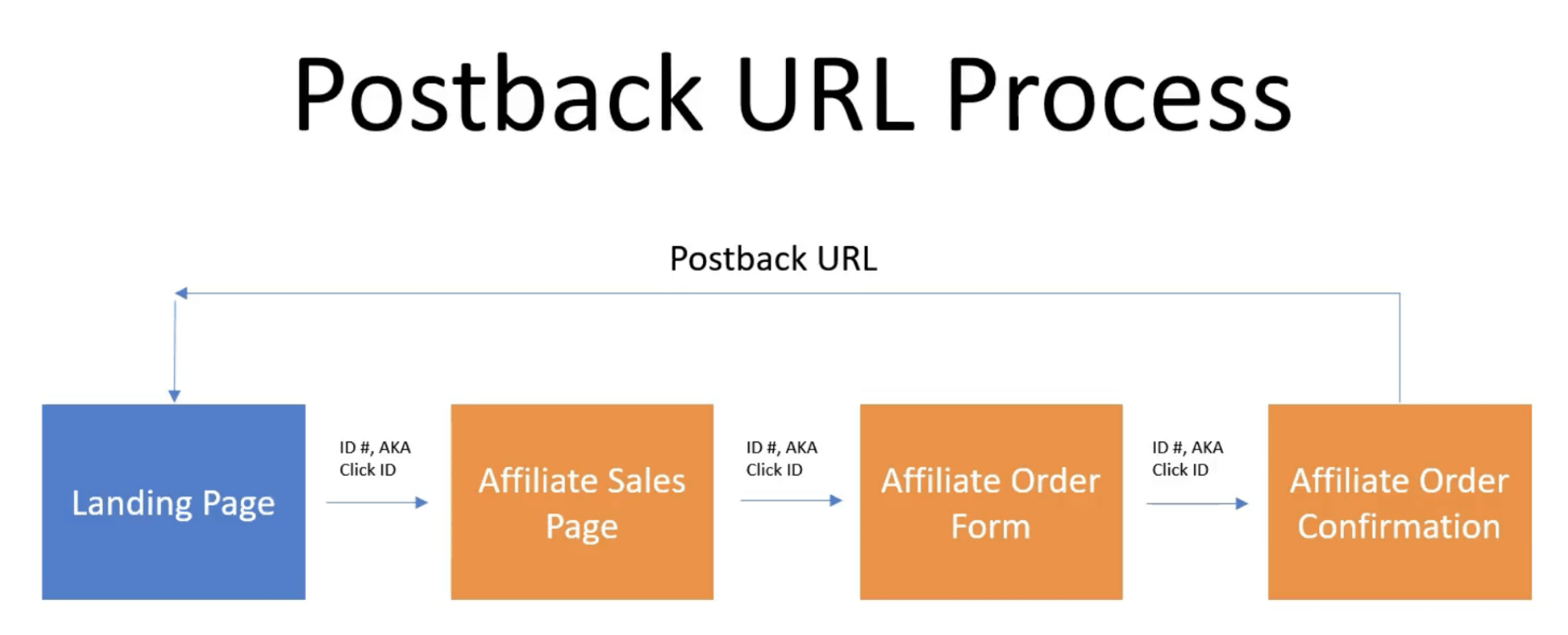
Is postback URL tracking more accurate than using cookies?
Yes, definitely.
How is the postback URL tracking running?
An affiliate network attaches tags to the URL of the advertiser called an ID.
Adding an ID to the merchant’s URL will change automatically as soon as the user hits the landing page. It’s a more complex process, but it guarantees better performance.
As I have already mentioned, there is an option to delete cookies from the browser or to surf in “Incognito Mode.” If the visitor does this, you’re not going to get your affiliate commission because no background or cookies are kept in Incognito mode.
This parameter will be maintained for as long as you remain on the pages of the online store. It can happen that the tracking parameter will vanish from the URL since there are two ways to move the value from one page to another.
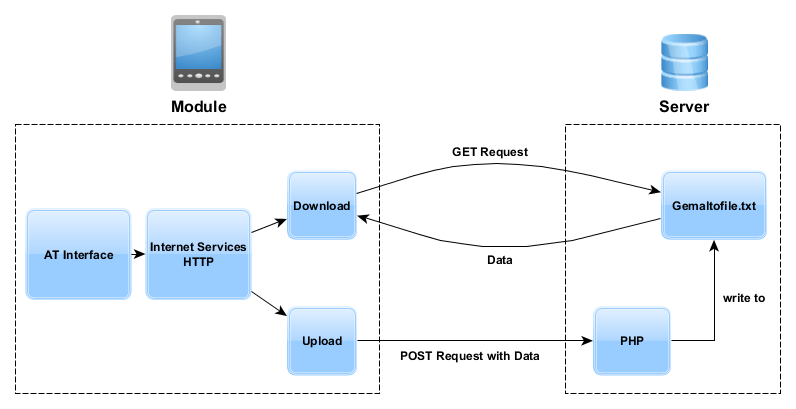
- Using the GET method: the parameter remains a part of the URL and is separated with the question mark and the path info.
- Using the POST method: the parameter is moved to the setting of the next page. This method is only available in HTML source code (such as form submission) or with appropriate tools.
Pixel Tracking
Affiliate campaign pixels enable affiliates to track conversions inside their own affiliate tracking platform. These pixels can be either iFrame, JavaScript, or Image pixels (HTML pixels) or Postback URLs (server-to-server tracking).
Pixel tracking is an easy and accurate way to track conversions.
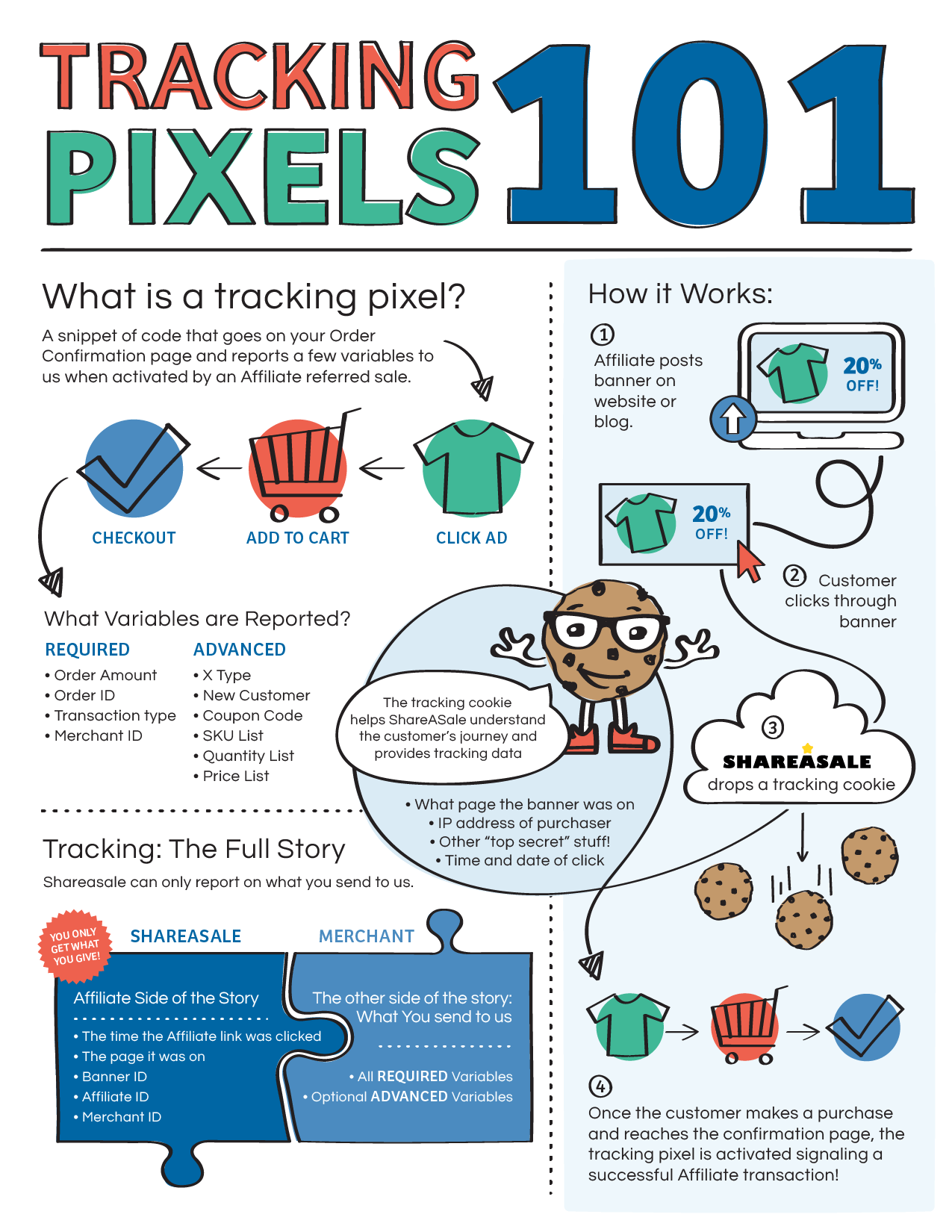
It’s simple to use, just take the ready-made pixel tracking code, and add it to the “Thank you” or any other page that confirms conversion.
There are four types of tracking pixels:
- The iFrame pixel is mounted in the form of an integrated frame on the website’s landing page.
- The image pixel is placed on the landing page as a 1×1 image – hence the name “pixel.”
- The JS pixel is applied to the site code as a script.
- S2S postback is the best and most accurate way of counting conversions.
All types of pixel functionality are similar in terms of application but use different backend methods. Pixels are used for statistics and conversion counting, but also, along with conversions, you can monitor and send parameters.
Affiliate Fingerprint Tracking

Fingerprint monitoring is a relatively recent innovation in affiliate marketing. A digital signature will be produced from your end device during this tracking process. This signature includes basic details about the end device, such as the operating system, the language, and the type/version of the browser.
Using this information, a unique signature is assigned to each end unit, which is later used to identify the user.
Fingerprint monitoring enables the user to be identified in various time sessions as long as they use the same computer and the same browser. As for other affiliate tracking methods – the tracking of cross-devices with fingerprint tracking is not possible.
Impressions / Views Tracking

In this method, the fee is paid even if the user does not directly click the ad. The use of cookies obtains the whole process. These cookies remember which advertisement is shown to the consumer.
Visits to the same destination can be monitored as purchases after seeing the commercial advertising beforehand. The affiliate would then obtain a commission. This gives a wide range of benefits to post-view monitoring, particularly to affiliate partners, while marketers criticize this process’s simple exploitation.
IP Affiliate Tracking
This method is used in two instances:
- If cookies cannot be identified, or
- When a user has no Flash Player installed
It’s a rare situation, but it does happen.
When monitoring the sales process, the platform searches for the last clicks from a known IP address. If the affiliate marketing network locates such clicks, a particular affiliate ID will be added to the affiliate so that they can receive their fee.
How does affiliate tracking work?
When you choose an affiliate marketing software, such as Scaleo, that will power your business; you will either get to choose the tracking method or use the most appropriate type of business and the most accurate one.
How are Affiliate transactions allocated to affiliates?
When an affiliate signs up to join the network, a specific affiliate ID is assigned to him by the network (For example, if you sign up as a Scaleo referral, you will have a publisher ID, referred to as a PID, expressed in a number such as 1234).
This ID is inserted into the affiliates’ URLs to advertise the brand’s goods and services. Publishers may use click references within this link to distinguish between websites and promotional slots.
This link can look like this:
https://scaleo.io/?ref=1234. When a visitor clicks on this link, they are led to the retailer’s website, and since the affiliate’s ID is embedded in the referral link, as well as the brand’s merchant ID, it allows unique assignments to the affiliate and merchant involved in the transaction, enabling the commission to be paid out precisely.
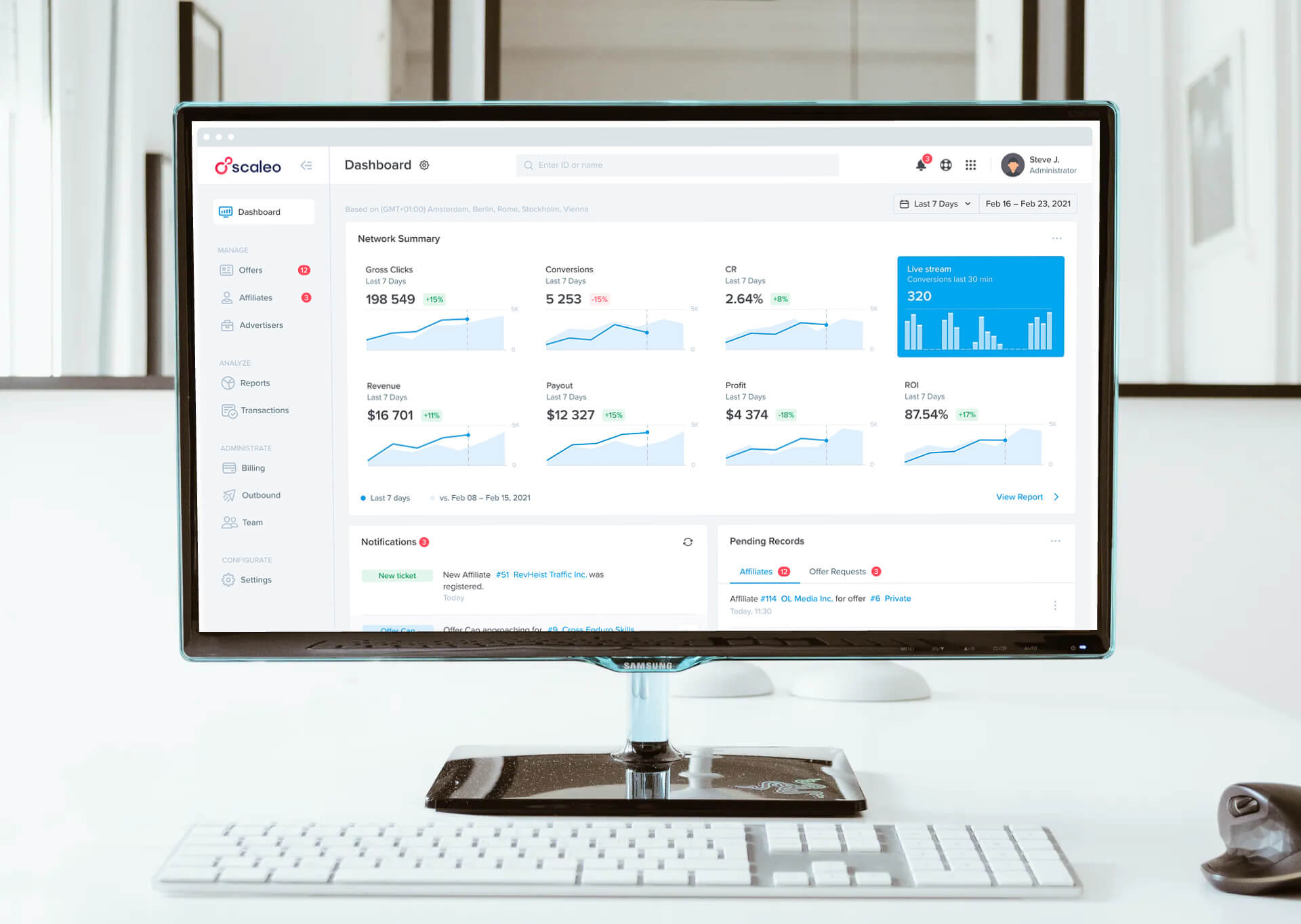
This monitoring feature helps advertisers recognize affiliates driving most of the traffic to a particular campaign or offer. The brand may decide to have different commission amounts per transaction for each of these types of affiliates, and so the uniqueness of each affiliate link helps to allow this versatility within the affiliate setup.
Through Scaleo’s dashboard, both advertisers and publishers are given greater visibility on their historical, current, and upcoming commission rates, enhancing the accuracy of allocation to affiliate transactions.
So, if you’ve ever purchased through a cashback platform and had your cashback tracked on your online account, the retailer could have used a particular affiliate model to track sales and commissions. With that being said, not all networks offer each affiliate a specific PID, but instead allocate each link to a PID.
Why do you need affiliate tracking software?
If you have made it that far into this post, you already understand that tracking is at the core of your affiliate business. However, you need a platform to run and manage this business, and this is where affiliate marketing software (such as Scaleo) comes into play—having access to real-time reporting to monitor your affiliate marketing activities and efforts.
Having a robust affiliate marketing tracking software with a customizable interface will allow you to access real-time metrics, real-time campaign tracking and fraud protection.

Affiliate tracking software (also sometimes referred to as affiliate marketing software, referral marketing software or performance tracking software) enables brands and affiliates to gain priceless insight into which elements of their online activities generate the largest number of visitors, conversions, and clicks.
This gives a clear view of whether an affiliate marketing strategy is working. Check out Starbucks’ marketing strategy to learn from this case study.
Affiliate networks provide various monitoring solutions that allow the ability to monitor several different metrics. This enables brands to partner with networks that integrate unique monitoring solutions and payment mechanisms ideally tailored to their brand’s main performance indicators (KPIs).
More and more affiliate marketers and business owners choose to direct their affiliate business through affiliate tracking tools. Thanks to advanced reporting features and intuitive interfaces, affiliate tracking tools such as Scaleo have recently gained enormous popularity.
Common affiliate tracking problems
As a pay-for-performance marketing discipline, how transactions are attributed is usually the primary determinant between success and failure.

The main issues with web-based monitoring in the affiliate industry are:
- Browser privacy settings, such as restrictions on third-party cookies – most notably Internet Tracking Prevention (ITP) on Safari Cookie notifications, were implemented as a response to GDPR Mobile user journeys and lack of in-app affiliate conversion tracking.
- Social networks that disallow third-party trackers.
- Advertiser guidelines sometimes prevent certain types of promotion.
Fraud in the affiliate marketing business
Read also: How to Prevent Fraud in Affiliate Marketing.
Some types of affiliate tracking are hard to bypass, while others can easily be played around with. Combating fraud requires understanding and identifying various types of fraud.

The most common ones are:
- Click injection: type of click spamming, exposed mainly on Android devices;
- Click spam: this sort of fraud occurs when a fraudster attributes clicks to users who haven’t made them and is absolutely unaware of this fact;
- Device farms: also known as phone farms or click farms. It is used to create fraudulent clicks, install and add mobile engagement;
- Cookie stuffing: consists of attaching multiple cookies to users without their knowledge;
- Proxy sales.
- Domain spoofing.
Scaleo’s in-built Anti-Fraud Logic protection algorithm will help you flag and eliminate all potential bad traffic sources and identify them in real-time.
These problems have progressively developed at the heart of a problem that has eroded confidence in affiliate monitoring.
The issues with unstable affiliate tracking conservatively cause a miss-rate of about 10% of affiliate channel transactions.
Code-based attribution
Although server-side tracking has been touted as an alternative to web-based tracking malfunctions, since it removes the need to submit a third-party HTTP/s request from an advertiser’s site, it is used by fewer than 5% of affiliate advertisers.

Does affiliate marketing need to be a code-based task?
It’s not a new idea.
A confirmation code is assigned to a channel or publisher at checkout to define the referring marketing channel, replace the conventional cookie relationship, and request conversion.
However, in the face of wilting tracking accuracy networks, the concept of confirmation codes is being reverted to as a method for crediting transactions to the affiliate channel. It seems like a no-brainer.
In reality, it has been used by publishers working directly with advertisers for a few years.
There is no need for those annoying, frequently unwanted, and much-dreaded cookies to ‘track’ that the user has interacted with the publisher. The existence of the code assigned to them is all the proof that is required.
It all sounds really easy. Right?
The main issue is that allowing the affiliate network to attribute by code would require tracking all transactions. Irrespective of the customer’s journey, where the code has been collected, or whether the code is where the network can take credit for the transaction. While this could be good news for publishers and networks, advertisers could lose control of cross-channel deduplication rules and run a significant risk of crediting affiliate commissions to transactions that they have never dealt with.
The presence of a code given directly to the publisher does not always indicate that the publisher was responsible for the distribution of the code.
Code leakage across the internet is very popular, particularly in the affiliate industry, and can happen as easily from a social influencer as it can from a confirmation code site.

When executed with the right technology and implementation, code can be a very useful addition, or even a secure alternative, to web-based tracking widely associated with affiliate marketing. Given that the affiliate industry is very discount-centric, it almost makes sense to use one of the most popular discount triggers – the code – to make transaction tracking more effective.
Cookie Session Duration

Each cookie should have an expiry date.
The length of the cookie varies. Some companies, such as Amazon, offer 24h cookie sessions, while others set cookie duration to 365 days. The default is often 30 days.
If a user enters your site through an affiliate link and purchases anything within 30 days, the affiliate that referred the user will receive a fee. If he made a purchase after the cookie had expired, the purchase would no longer be credited to him.
You can increase the cookie’s duration to give your affiliates a longer-term time frame for crediting the commission. Unfortunately, there is no way to set the cookie’s duration to “forever.” You can specify a very large number, like 32000 (which is about 100 years) – that way, the cookie is never going to expire.
Clicks from 2 different affiliates – who gets the commission?
The affiliate industry is based on the principle that ‘Last Click Wins,’ which means that any new click can overwrite a cookie under normal circumstances.

This commission shall then be credited to the last referred affiliate.
However, there are several multi-assignment models where the last click model is insufficient due to multiple affiliates affecting a single user journey. In these cases and in the cookie hierarchy, the affiliate attributed to the sale can differ, depending on various factors.
How to make sure your affiliate commissions are always tracked?

As you can see, with the enormous effort on the advertisers’ and affiliate networks’ part – there is never a 100% way to guarantee that 100% of all commissions will be attributed to the affiliate.
The user can erase the cookies from their browser, and they can surf, compare and analyze at work and then finalize the purchase on their home PC. Moreover, the user can purchase after the cookie session has expired.
Bearing in mind all of the above, it’s safe to say that postback URL tracking has been a safer and more bulletproof alternative to traditional cookie tracking used in affiliate marketing for over a decade now.
Apart from opting in for postback URL tracking, you should also use powerful affiliate marketing software to power your business and track transactions. Unbeatable uptime and a robust backend will ensure your business runs smoothly.
It is important to carefully evaluate the different tracking methods and choose the one that best meets the needs of your affiliate marketing campaigns.
Looking for affiliate software that allows you to choose a tracking method and ensures 100% tracking accuracy? Try Scaleo free for 14 days and get a first-hand experience with the industry’s top software.
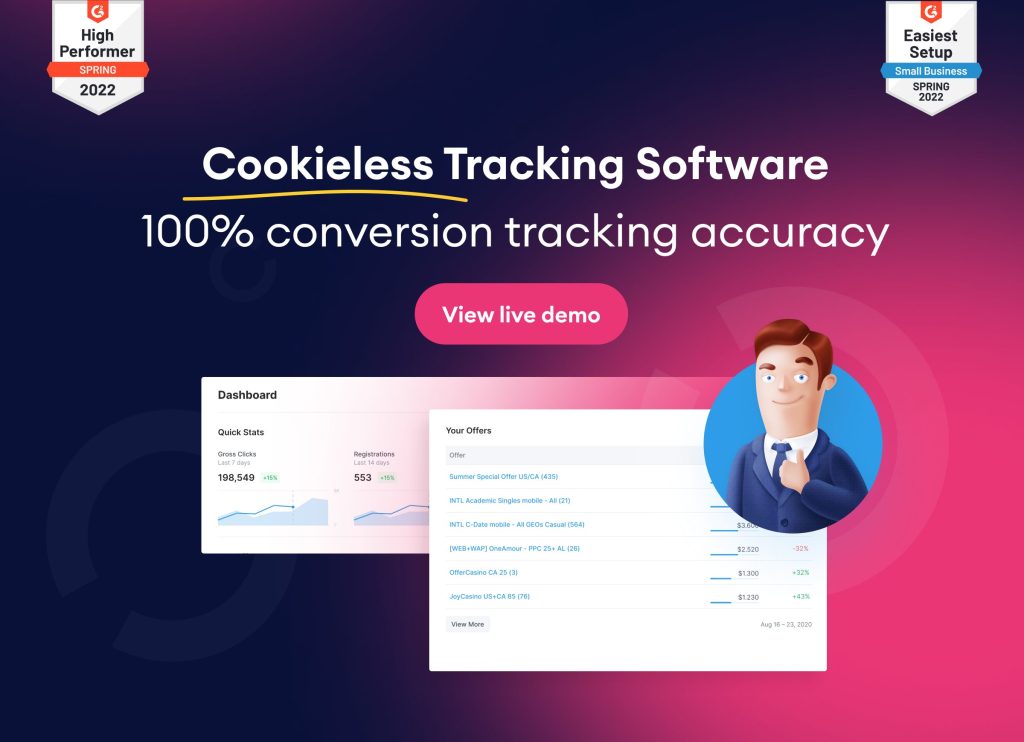
Conclusion
Suppose you are an affiliate or a retailer. In that case, the secret to success is to choose a sustainable long-term marketing plan, coupled with high-quality affiliate software, a large community, and a promotion strategy. To deliver the above, having a reliable affiliate performance tracking solution is important, monitor lead generation, measure purchase conversions, and reward affiliates for their efforts.
It is important to use tracking tools if you want to monitor the output of your affiliates. There are several affiliate marketing tracking methods, so you can choose the right one depending on the field you’re operating in or on the initiative you’re supporting. Postback URL tracking is a more reliable and secure alternative to traditional cookie tracking. Once you choose a reliable affiliate management software, collaboration with affiliates will be automatic, seamless, and effortless.
FAQ
How to track affiliate campaigns run through mobile traffic?
When it comes to affiliate tracking solutions, they typically track any kind of traffic, regardless of the referring URL. If your affiliate links are configured correctly, you should have no problem tracking your affiliate sales through the web interface, mobile, or app.
What is affiliate network tracking software?
Affiliate network tracking software basically refers to any affiliate software that is complex enough to power a whole affiliate network, not just a standalone partner program for a vendor. If you are looking to launch your own network, you will need software that covers all your needs.
What are the best affiliate marketing tracking methods for 2024?
In 2024 and beyond, when cookies become an issue, the best affiliate marketing tracking methods include cross-platform cookieless tracking, which is the best way to guarantee that all commissions are logged and properly attributed.
Last Updated on December 8, 2023





